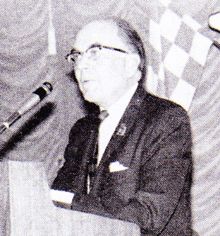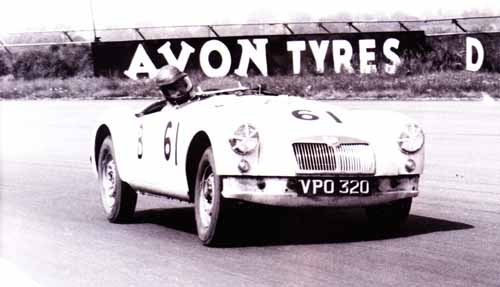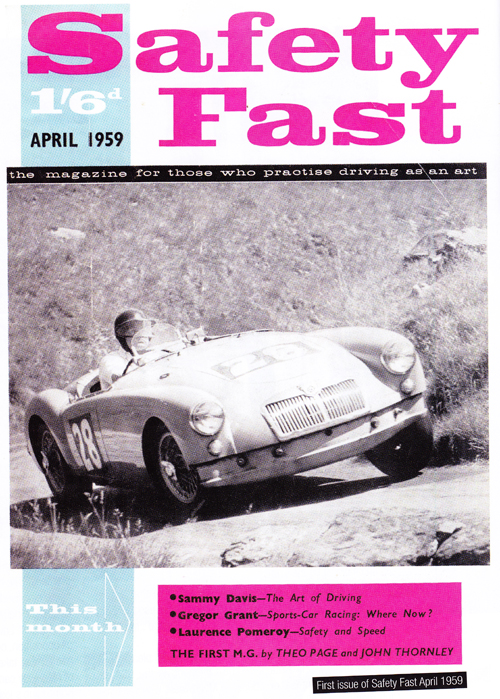History of the MG Car Club: Part 6

 Part 6 of this multi-part series of the MG Car Club History covers the Sixties from 1959 – 1969. Wilson McComb established Safety Fast! in 1959 and subsequently became MG Car Club General Secretary in 1963.
Part 6 of this multi-part series of the MG Car Club History covers the Sixties from 1959 – 1969. Wilson McComb established Safety Fast! in 1959 and subsequently became MG Car Club General Secretary in 1963.
When I came to Abingdon in February 1959 I found a brand new office awaiting me within the MG factory. I was surrounded by delectable new sports cars, and I drove them far and fast (for there were no overall speed limits then). My days were devoted to producing a monthly magazine for enthusiasts like myself and it was my good fortune to have as my chief, John Thornley, who expected me to get on with the job and assumed (since he had chosen me for it) that I knew what I was doing. The evenings, as often or not, would be spent browsing through dusty files in the always-fascinating study of MG history. And before long Gordon Cobban, with almost incredible generosity allowed me to use his MGA for races, sprints and hill climbs, I could say that this was the happiest period of my life, and it would be the truth.

But not the whole truth, because life isn’t like that. In the men’s room of a certain New York restaurant there used to be a sign that read, ”We aim to please. You aim too, please”. ln editing the original Safety Fast! I also aimed to please.
The trouble was, there were so many folk to please: MG Car Club members in Britain, on the Continent, in the USA, or Australia, or South Africa, or wherever; MG owners who were not Club members at all and saw no reason why they should be; ex-MG owners who were to be wooed back to the fold, if possible; and that always incomprehensible bunch of non-motoring, non-enthusiasts, the management of the British Motor Corporation.
They, since they were paying the pipet rather naturally wanted to call the tune. I was expected to make enthusiastic noises about all BMC cars, even the horrible ones. I was instructed to form an Austin-Healey Club, which would share Safety Fast! as its official organ. Many an MGCC member protested loudly, for the Club subscription had gone up from 25/- to 35/- (remember those funny old shillings?) and the reasoning was: “It’s our magazine, we’re paying for it, and we should decide on its contents.” Actually of course, the extra ten bob covered little more than postage, and the magazine was heavily subsidised by BMC (as was the Club itself).

So while Safety Fast! radiated confidence and contentment, there were many problems beneath the surface. Especially there was a shortage of suitable MGs for Club members, the revived Midget being still in the future and the lamented ZB having given way to the less popular Mark lll Magnette. Even MGA sales were a bit dodgy; they picked up with the announcement of the new 1600 model, but soon fell away after that. And MGCC membership reflected the same pattern: for over several years the numbers fell both at home and abroad after reaching a peak of 7,500 (3,000 home, 4,500 overseas). The heaviest and most lasting blow fell abroad, where the figure stabilised at about 3,000 members, although the number of Centres actually rose.
Russell Lowry’s courageous adherence to rule 2(a), despite all opposition, certainly weeded out a host of non MG owners who had almost taken over the Club in some places. The justification of his policy came shortly after his retirement, for by 1964 all the Home Club’s losses had been made good.
100,000th MGAThe 100,000th MGA coming off the line in 1962.
Another important factor was the successive appearance of the new Midget (mid-1961), the MG version of the 1100 (late 1962), the MGB two-seater (late 1962) and GT (late 1965). By 1967 the home membership was well over 5,000, by 1968 it was 6,000, and there were eight Centres plus two sub-Centres in the Home Club, no fewer than 43 overseas Centres, and 500 unattached overseas members. 0ver 9,000 altogether. We in Britain had become particularly chummy with some of the overseas Centres, and the Club was doing very nicely, thank you; this despite (or more probably because of the fact that from early 1964 to mid-1967 I had been mainly occupied by my work as press officer to the all conquering BMC rally team of Hopkirk, Makinen and Aaltonen in their fire eating Mini-Coopers. Then, just when everything in the garden was lovely, the very thing that Russell had always feared started to happen.
Following a change of BMC top brass, a most determined attempt was made to utilise the Club for a mammoth, worldwide MG selling exercise. To emphasise that MGCC members are not unpaid MG salesmen, the appropriate number of digits was displayed to BMC.
Now, this is a dangerous game to play at any time. It was perhaps unduly tactless to make such a gesture early in 1968, only a few months before BMC so suddenly turned into BLMC, because that little development led to our being weighed in the balance and found wanting.
So poor old Safety Fast! got the chopper and before the end of the year the Club’s financial backing was withdrawn, and l, having been axed, returned to my freelance typewriter. If Russell wants to be remembered for his back-to-MG policy, my deepest satisfaction comes from remembering that more than 15 years ago I foresaw the increasing interest in early MG models and supported the Register cause on every possible occasion.
Wilson McComb arrived at MG in 1959 to start up the new Safety Fast! magazine, and by the time he left Abingdon ten years later he had become without doubt the most authoritative MG archivist and historian.
Born and brought up in Ulster, educated at Queens lJniversity, Belfast, his early love of cars and Irish motorsport led him to work as local contributor to Autosport, later becoming assistant editor and to work as a motoring correspondent for the BBC in Northern lreland. He progressed to be editor of the prestigious Autocourse annual and it was his style of writing that caught the eye of John Thornley who was on the look out for someone to launch the new Safety Fast!.
Wilson soon found himself in his element with the challenge of establishing the new magazine but he also realised that, apart from the original pre-war chassis files and some incomplete and often far from accurate production documents, there was no official MG archive.
Research was meticulous and time consuming and Wilson would never publish facts or figures until they had been crosschecked every conceivable way. He was well aware when interviewing older members of the Company whose memories were fading that their stories always had to be double-checked with other sources. As his articles appeared in Safety Fast! these prompted contact with people far and wide, many of whom had lost contact with Abingdon, and Wilson never lost an opportunity to welcome them back to the fold.
As the magazine for the MG Car Club, it was not long before Wilson was corresponding with owners all over the world on all sorts of subjects, not the least of which were technical queries, and he took it upon himself to become the ‘factory customer help desk’. And if he did not know the answers himself, he would always find someone who did.
When Russell Lowry retired as MGCC General Secretary in 1963, Wilson moved on from Safety Fast! to take on the job, which he did very effectively for four years before handing over to Gordon Cobban. During this period he was also appointed BMC Competitions Press Officer and regularly travelled with the team on races and rallies, keeping the media fully informed of the teams successes.
The BL takeover of MG, and the final closure of the factory and the withdrawal of support for the motor clubs, brought a sad end to Wilson’s time at Abingdon, He retired to Chichester to pursue his love of boating, where he died of a heart illness in 1989.
NAMGAR would like to thank Andy Knott, Editor, Safety Fast! for his kind permission to reproduce these articles.

